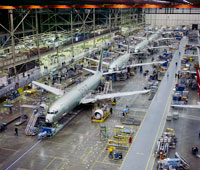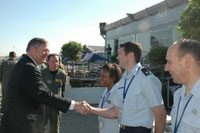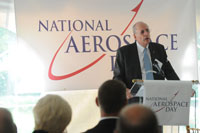At the Aerospace Industries Association we like to say that we represent the companies (and their suppliers) that build just about everything that flies. In September, AIA will hold our second annual National Aerospace Day, which we’ve expanded to a week to commemorate our industry and celebrate its many accomplishments. We believe we have much to be proud of:
The aerospace and defense industry is a strong contributor to the U.S. economy, vital to our national security interests and a global leader in technological innovation.
The industry directly employs 844,000 workers and supports 2.2 million middle-class jobs in related fields. There are more than 30,000 aerospace and defense suppliers in all 50 states.
As America’s leading manufacturing export industry, aerospace contributes a positive balance of $56 billion to U.S. trade, the largest of any manufacturing sector. Last year the industry’s exports totaled $81 billion, providing an important boost to our economy.
We are leading the modernization of America’s aviation infrastructure and maintaining our leadership in space.
Aerospace technology innovation creates jobs, expands markets and improves our balance of trade. Aerospace and defense research and development secure our nation’s future and industrial base.
The industry’s workforce is highly skilled, leading our nation in global competitiveness. The workforce is comprised of proud, productive and patriotic citizens and there are growing opportunities for young people to have an exciting and well-paying career in the industry.
The Organization Now, let me tell you something about our organization. In 2009, AIA celebrated its 90th anniversary as the premier trade association representing the nation’s major aerospace and defense manufacturers and their suppliers. Based in Arlington, Virginia, our offices overlook historic Fort Myer, where the Wright brothers tested the first military aircraft.
Now, let me tell you something about our organization. In 2009, AIA celebrated its 90th anniversary as the premier trade association representing the nation’s major aerospace and defense manufacturers and their suppliers. Based in Arlington, Virginia, our offices overlook historic Fort Myer, where the Wright brothers tested the first military aircraft.
AIA represents more than 100 leading aerospace and defense manufacturers, along with a supplier base of nearly 200 associate members. As a result, we maintain a broad political footprint and a compelling voice in Washington, D.C. and beyond.
AIA is at the forefront of critical issues, such as ensuring a strong U.S. industrial base, advocating for defense modernization and acquisition reform, increasing deployment of Next Generation Air Transportation System technologies and equipment, modernizing export controls and obtaining additional resources for aeronautics research and space exploration.
 Unlike other associations, CEOs of our member companies and their senior managers define and drive our agenda. We work together to shape the regulatory and legislative policies that ensure a strong industry for a safe America. AIA also provides unlimited networking opportunities with primes, peers, and suppliers through meetings, international air shows, and an extensive network of councils and committees. AIA is also a leader in developing and publishing national aerospace standards used in aerospace design and manufacturing across the globe.
Unlike other associations, CEOs of our member companies and their senior managers define and drive our agenda. We work together to shape the regulatory and legislative policies that ensure a strong industry for a safe America. AIA also provides unlimited networking opportunities with primes, peers, and suppliers through meetings, international air shows, and an extensive network of councils and committees. AIA is also a leader in developing and publishing national aerospace standards used in aerospace design and manufacturing across the globe.
AIA is led by a Board of Governors that meets twice a year and consists of senior representatives (generally chief executive officers) of member companies, and an Executive Committee that meets more frequently. Our senior staff have decades of experience in the highest levels of government and industry. The government frequently seeks advice from AIA on issues, and we provide a forum for government and industry representatives to exchange views and resolve problems on non-competitive matters related to the aerospace industry.
 AIA member company representatives sit on various councils and committees in these areas and, supported by our staff, formulate industry positions on specific issues for approval by the Executive Committee and the Board of Governors. The association concentrates on issues covering national security, civil aviation and space. In addition, the association has departments for Communications, Legislative Affairs, Acquisition Policy, Membership Services, the Supplier Management Council and the Aerospace Research Center.
AIA member company representatives sit on various councils and committees in these areas and, supported by our staff, formulate industry positions on specific issues for approval by the Executive Committee and the Board of Governors. The association concentrates on issues covering national security, civil aviation and space. In addition, the association has departments for Communications, Legislative Affairs, Acquisition Policy, Membership Services, the Supplier Management Council and the Aerospace Research Center.
The aerospace industry is a cornerstone of our economy, as well as a wellspring for much of the technology and innovation that gives the United States its global lead. It’s also an industry that’s been remarkably resilient in the face of economic adversity. Certainly, compared to other manufacturing sectors, aerospace has more than held its own. Total aerospace industry sales reached $214.1 billion in 2009, a record for the sixth straight year. And for this year, we believe we’re going to hold pretty steady.
We advocate on many issues of concern to our membership, but some have risen to the top of the priority list. Here’s a brief description of those issues.
Accelerating the Implementation of the Next Generation Air Transportation System
The National Airspace System would be far more efficient if aircraft flew in straight lines instead of zigzagging their way from point to point. Planes would get passengers to destinations faster and burn less fuel along the way. NextGen includes more than two dozen projects that will transform the air traffic control system by 2025. It will replace today’s radar-based system, which relies on extensive voice communication between controllers and pilots, with GPS.
Studies show the public can expect many benefits from a federally funded, NextGen-equipped civil fleet: dramatically reduced carbon dioxide emissions, shortened travel times, reduced delays and more than 150,000 new jobs. The $1.14 billion in the Federal Aviation Administration’s budget for NextGen programs is enough to keep the current 2025 implementation schedule, but not to accelerate the program. We can get a faster return on our investment if we accelerate our investment in NextGen.
Modernizing the Nation’s Export Control System
Last year, the Obama Administration announced a review of the export control regime. In response, AIA suggested a number of initiatives to modernize the system in a letter to the President signed by more than 100 CEOs in our industry.

Developing a Global Agreement on Ethical Business Practices
Two years ago, leaders of AIA and the AeroSpace and Defence Industries Association of Europe began developing a set of principles that would guide the global aerospace and defense industry. A meeting in Helsinki Oct. 2, 2009, marked the first time aerospace associations from different regions came together to affirm the Global Principles for the Aerospace and Defense Industry. As part of our commitment to zero tolerance for corruption, full compliance with all anti-bribery laws is required under the Global Principles. Businesses will also establish and enforce policies and internal control procedures that prohibit a firm and its employees from promising or providing incentives to obtain any improper competitive advantage.
Maintaining a Highly Skilled, Stable, Secure and Renewable Aerospace Workforce
AIA continues to be the leading advocate for maintaining the U.S. edge in having the most skilled and innovative aerospace workforce in the world. The effort is twofold. First, there must be reliable and consistent aerospace programs to employ these highly skilled workers. Second, the U.S. must be aggressive in attracting the next generation of workers to defense, space and civil aviation jobs.
Increasing High School and College Study of the STEM disciplines In March, with AIA’s leadership, nearly 30 business and industry organizations formed a new coalition to augment the future workforce by promoting study of science, technology, engineering and mathematics—the so-called STEM disciplines. Goals of the coalition include doubling the number of U.S. STEM bachelor degree graduates to 400,000 from 200,000 by 2020.
In March, with AIA’s leadership, nearly 30 business and industry organizations formed a new coalition to augment the future workforce by promoting study of science, technology, engineering and mathematics—the so-called STEM disciplines. Goals of the coalition include doubling the number of U.S. STEM bachelor degree graduates to 400,000 from 200,000 by 2020.
Modernizing Our Equipment and Reforming Our Acquisition System
We continue to press for modernization of our defense forces and material support. The nation should commit to a floor of investing at least 4 percent of Gross Domestic Product in its defense budget. Moreover, government and industry agree that there is a major disconnect in the defense acquisition process regarding requirements, programs and budgets. This critical element of the defense acquisition process must be repaired.
Maintaining the Health of the Industrial Base in Defense Planning
Finally, we are pleased that the recently released Quadrennial Defense Review cited the industrial base as an important factor to be considered in the Defense Department’s strategic planning. The health of the industrial base is at the heart of our ability to supply our nation with the weapons systems it requires.
The key to keeping our industry strong is to make sure investments in defense, civil aviation and space remain strong. Even with the financial challenges faced by the federal government, cutting corners in these areas is counterproductive. Aerospace has the strength to lift America, and this is a message AIA is proud to convey.

